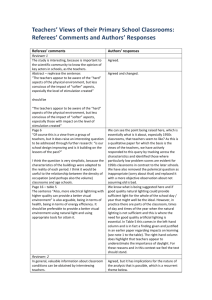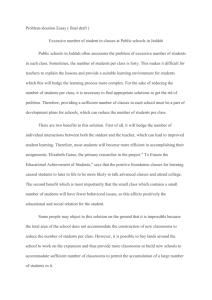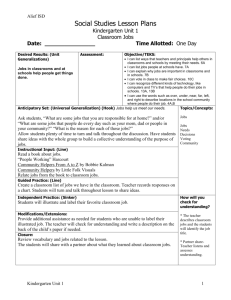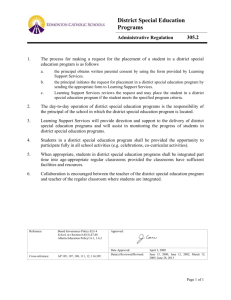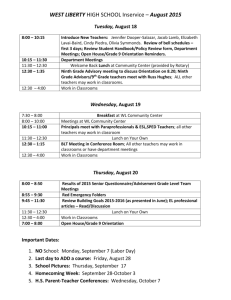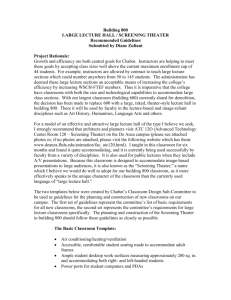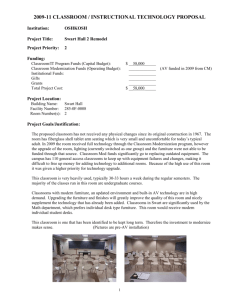AdoptedRules02012-00982 - Colorado Secretary of State
advertisement
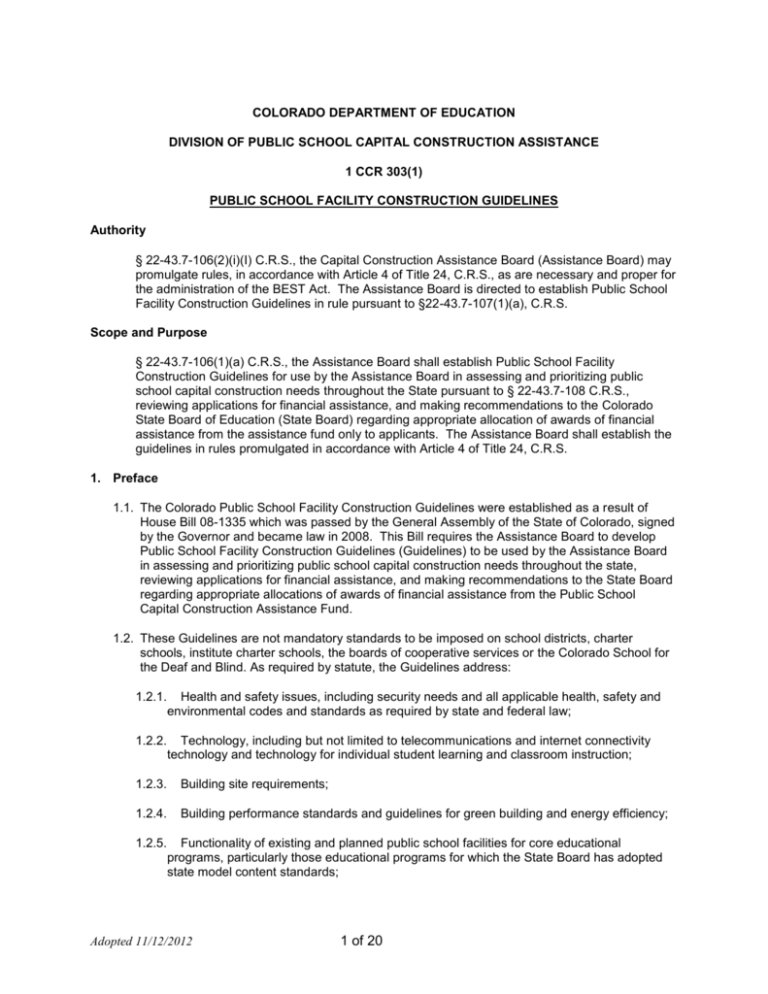
COLORADO DEPARTMENT OF EDUCATION DIVISION OF PUBLIC SCHOOL CAPITAL CONSTRUCTION ASSISTANCE 1 CCR 303(1) PUBLIC SCHOOL FACILITY CONSTRUCTION GUIDELINES Authority § 22-43.7-106(2)(i)(I) C.R.S., the Capital Construction Assistance Board (Assistance Board) may promulgate rules, in accordance with Article 4 of Title 24, C.R.S., as are necessary and proper for the administration of the BEST Act. The Assistance Board is directed to establish Public School Facility Construction Guidelines in rule pursuant to §22-43.7-107(1)(a), C.R.S. Scope and Purpose § 22-43.7-106(1)(a) C.R.S., the Assistance Board shall establish Public School Facility Construction Guidelines for use by the Assistance Board in assessing and prioritizing public school capital construction needs throughout the State pursuant to § 22-43.7-108 C.R.S., reviewing applications for financial assistance, and making recommendations to the Colorado State Board of Education (State Board) regarding appropriate allocation of awards of financial assistance from the assistance fund only to applicants. The Assistance Board shall establish the guidelines in rules promulgated in accordance with Article 4 of Title 24, C.R.S. 1. Preface 1.1. The Colorado Public School Facility Construction Guidelines were established as a result of House Bill 08-1335 which was passed by the General Assembly of the State of Colorado, signed by the Governor and became law in 2008. This Bill requires the Assistance Board to develop Public School Facility Construction Guidelines (Guidelines) to be used by the Assistance Board in assessing and prioritizing public school capital construction needs throughout the state, reviewing applications for financial assistance, and making recommendations to the State Board regarding appropriate allocations of awards of financial assistance from the Public School Capital Construction Assistance Fund. 1.2. These Guidelines are not mandatory standards to be imposed on school districts, charter schools, institute charter schools, the boards of cooperative services or the Colorado School for the Deaf and Blind. As required by statute, the Guidelines address: 1.2.1. Health and safety issues, including security needs and all applicable health, safety and environmental codes and standards as required by state and federal law; 1.2.2. Technology, including but not limited to telecommunications and internet connectivity technology and technology for individual student learning and classroom instruction; 1.2.3. Building site requirements; 1.2.4. Building performance standards and guidelines for green building and energy efficiency; 1.2.5. Functionality of existing and planned public school facilities for core educational programs, particularly those educational programs for which the State Board has adopted state model content standards; Adopted 11/12/2012 1 of 20 1.2.6. 1.2.7. 1.2.8. Capacity of existing and planned public school facilities, taking into consideration potential expansion of services and programs; Public school facility accessibility; and The historic significance of existing public school facilities and their potential to meet current programming needs by rehabilitating such facilities. 2. Mission Statement 2.1. The “Colorado public school facility construction guidelines” shall be used to assess and prioritize public schools capital construction needs throughout the state, review applications for financial assistance, make recommendations to the State Board regarding appropriate allocations of awards of financial assistance from the Public School Capital Construction Assistance Fund, and help ensure that awarded grant moneys will be used to accomplish viable top priority construction projects. 3. SECTION ONE - Promote safe and healthy facilities that protect all building occupants against life safety and health threats, are in conformance with all applicable Local, State and Federal, codes, laws and regulations and provide accessible facilities for the handicapped and disabled as follows: 3.1. Sound building structural systems. Each building should be constructed and maintained with a sound structural foundation, floor, wall and roof systems. Local snow, wind exposure, seismic, along with pertaining importance factors shall be considered. 3.2. A weather-tight roof that drains water positively off the roof and discharges the water off and away from the building. All roofs shall be installed by a qualified contractor approved by the roofing manufacturer to install the specified roof system and shall receive the specified warranty upon completion of the roof. The National Roofing Contractors Association (NRCA) divides roofing into two generic classifications: low-slope roofing and steep-slope roofing. Low-slope roofing includes water impermeable, or weatherproof types of roof membranes installed on slopes of less than or equal to 3:12 (fourteen degrees). Steep slope roofing includes watershedding types of roof coverings installed on slopes exceeding 3:12 (fourteen degrees); 3.2.1. Low-slope roofing: 3.2.1.1. Built-up-Roofing (BUR); 3.2.1.2. Ethylene Propylene Diene Monomer (EPDM); 3.2.1.3. Poly Vinyl Chloride (PVC); 3.2.1.4. Co-Polymer Alloy (CPA); 3.2.1.5. Thermal Polyolefin (TPO); 3.2.1.6. Metal panel roof systems for low slope applications; 3.2.1.7. Polymer-modified bitumen sheet membranes; 3.2.1.8. Spray polyurethane foam based roofing systems (SPF) and applied coatings; 3.2.1.9. Restorative coatings. Adopted 11/12/2012 2 of 20 3.2.2. Steep slope roofing systems: 3.2.2.1. Asphalt shingles; 3.2.2.2. Clay tile and concrete tile; 3.2.2.3. Metal roof systems for steep-slope applications; 3.2.2.4. Slate; 3.2.2.5. Wood shakes and wood shingles; 3.2.2.6. Synthetic shingles; 3.2.2.7. Restorative coatings. 3.3. A continuous and unobstructed path of egress from any point in the school that provides an accessible route to an area of refuge, a horizontal exit, or public way. Doors shall open in the direction of the path of egress, have panic hardware when required, and be constructed with fire rated corridors and area separation walls as determined by a Facility Code Analysis. The Facility Code Analysis shall address, at a minimum, building use and occupancy classification, building type of construction, building area separation zones, number of allowed floors, number of required exits, occupant load, required areas of refuge and required fire resistive construction. 3.4. A potable water source and supply system complying with 5CCR 1003-1 “Colorado Primary Drinking Water Regulations” providing quality water as required by the Colorado Department of Public Health and Environment. Water quality shall be maintained and treated to reduce water for calcium, alkalinity, Ph, nitrates, bacteria, and temperature (reference, Colorado Primary Drinking Water Act and EPA Safe Water Drinking Act). The water supply system shall deliver water at a minimum normal operating pressure of 20 psi and a maximum of 100 psi to all plumbing fixtures. Independent systems and wells shall be protected from unauthorized access. 3.5. A building fire alarm and duress notification system in all school facilities designed in accordance with State and Local fire department requirements. Exceptions include unoccupied very small single story buildings, sheds and temporary facilities where code required systems are not mandatory and the occupancy does not warrant a system. 3.6. Facilities with safely managed hazardous materials such as asbestos found in Vinyl Asbestos Tile and mastic, acoustical and thermal insulation, window caulking, pipe wrap, roofing, ceiling tiles, plaster, lead paint and other building materials. Public schools shall comply with all Asbestos Hazard Emergency Response Act (AHERA) criteria and develop, maintain and update an asbestos management plan kept on record at the school district. 3.7. Facilities choosing to utilize closed circuit video and keycard or keypad building access. 3.8. An Event Alerting and Notification system (EAN) utilizing an intercom/phone system with communication devices located in all classrooms and throughout the school to provide efficient inter-school communications and communicate with local fire, police and medical agencies during emergency situations. 3.9. Secured facilities including a main entrance and signage directing visitors to the main entrance door. The main entrance walking traffic should flow past the main office area and be visibly monitored from the office either directly or through a less preferred mechanism like a video camera system. All other exterior entrances shall be locked and have controlled access. Adopted 11/12/2012 3 of 20 Interior classroom doors shall have locking hardware for lock downs and may have door sidelights or door vision glass that allow line of sight into the corridors during emergencies. 3.10. Safe and secure electrical service and distribution systems designed and installed to meet all applicable State and Federal codes. The electrical system shall provide artificial lighting in compliance with The Illumination Engineering Society of North America (IESNA) for educational facilities RP-3-00. Emergency lighting shall be available when normal lighting systems fail and in locations necessary for orderly egress from the building in an emergency situation as required by electrical code. 3.10.1. The material hereby incorporated by reference in these rules is the “RP-3-00, Lighting for Educational Facilities” produced by The Illumination Engineering Society of North America (IESNA). 2006 reaffirmed. 3.10.2. Later Amendments to the “RP-3-00, Lighting for Educational Facilities” are excluded from these rules. 3.10.3. The Director of the Division of Public School Capital Construction Assistance, 1580 Logan St. Denver, Colorado will provide information regarding how the “RP-3-00, Recommended Practice on Lighting for Educational Facilities” may be obtained or examined. 3.11. A safe and efficient mechanical system that provides proper ventilation, and maintains the building temperature and relative humidity in accordance with the most current version of ASHRAE 55. The mechanical system shall be designed, maintained and installed utilizing current State and Federal building codes. 3.11.1. The material hereby incorporated by reference in these rules is the “Thermal Environmental Conditions for Human Occupancy (ASHRAE Standard 55)” produced by the American Society of Heating, Refrigeration and Air-Conditioning Engineers, Inc. 2010 Update. 3.11.2. Later Amendments to the “Thermal Environmental Conditions for Human Occupancy (ASHRAE Standard 55)” are excluded from these rules. 3.11.3. The Director of the Division of Public School Capital Construction Assistance, 1580 Logan St. Denver, Colorado will provide information regarding how the “Thermal Environmental Conditions for Human Occupancy (ASHRAE Standard 55)” may be obtained or examined. 3.12. Healthy building indoor air quality (IAQ) through the use of the mechanical HVAC systems or operable windows and by reducing outside air and water infiltration with a tight building envelope. 3.13. Sanitary school facilities that comply with Colorado Department of Public Health and Environment (CDPHE), Consumer protection Division, 6 CCR 1010-6 “Rules and Regulations Governing Schools.” 3.14. Food preparation and associated facilities equipped and maintained to provide sanitary facilities for the preparation, distribution, and storage of food as required by Colorado Retail Food Establishment Rules and Regulations 6 CCR 1010-2. 3.15. Safe laboratories, shops and other areas storing paints or chemicals that complying with CDPHE 6CCR 1010-6 “Rules Governing Schools.” Adopted 11/12/2012 4 of 20 3.15.1. In laboratories, shops, and art rooms where toxic or hazardous chemicals, hazardous devices, or hazardous equipment are stored, all hazardous materials shall be stored in approved containers and stored in ventilated, locked, fire resistive areas or cabinets. Where an open flame is used, an easily accessible fire blanket and extinguisher must be provided. Fire extinguishers shall be inspected annually. Where there is exposure to skin contamination with poisonous, infectious, or irritating materials, an easily accessible eyewash fountain/shower along with an independent hand washing sink must be provided. The eyewash station must be clean and tested annually. Master gas valves and electric shut-off switches shall be provided for each laboratory, shop or other similar areas where power or gas equipment is used; 3.15.2. All facility maintenance supplies, e.g. cleaning supplies, paints, fertilizer, pesticides and other chemicals required to maintain the school shall be stored in approved containers and stored in ventilated, locked and fire resistive rooms or cabinets. 3.16. A separate emergency care room or emergency care area shall be provided. This room shall have a dedicated bathroom, and shall be used in providing care for persons who are ill, infested with parasites, or suspected of having communicable diseases. Every emergency care room or area shall be provided with at least one cot for each 400 students, or part thereof, and be equipped with a locking cabinet for prescriptions and first aid supplies. 3.17. A facility that complies with the American Disabilities Act (ADA) providing accessibility to physically disabled persons. 3.18. A site that safely separates pedestrian and vehicular traffic and is laid out with the following criteria: 3.18.1. Physical routes for basic modes (busses, cars, pedestrians, and bicycles) of traffic should be separated as much as possible from each other. If schools are located on busy streets and/or high traffic intersections, coordinate with the applicable municipality or county to provide for adequate signage, traffic lights, and crosswalk signals to assist school traffic in entering the regular traffic flow. This effort should include planning dedicated turn lanes; 3.18.2. When possible, provide a dedicated bus staging and unloading area located away from students, staff, and visitor parking. Curbs at bus and vehicle drop-off and pick-up locations shall be raised a minimum of six inches above the pavement level and be painted yellow. Provide ‘Busses Only’ and ‘No entry Signs’ at the ends of the bus loop; 3.18.3. Provide an adequate driveway zone for stacking cars on site for parent drop-off/pick-up zones. Drop-off area design should not require backward movement by vehicles and be one-way in a counterclockwise direction where students are loaded and unloaded directly to the curb/sidewalk. Do not load or unload students where they have to cross a vehicle path before entering the building. It is recommended all loading areas have “No Parking” signs posted; 3.18.4. Solid surfaced staff, student, and visitor parking spaces should be identified at locations near the building entrance and past the student loading area; 3.18.5. Provide well-maintained sidewalks and a designated safe path leading to the school entrance. Create paved student queuing areas at major crossings and paint sidewalk “stand-back lines” to show where to stand while waiting. Except at pick-up locations, sidewalks shall be kept a minimum of five feet away from roadways. There should be wellmaintained sidewalks that are a minimum of eight feet wide leading to the school and circulating around the school; Adopted 11/12/2012 5 of 20 3.18.6. Building service loading areas and docks should be independent from other traffic and pedestrian crosswalks. If possible, loading areas shall be located away from school pedestrian entries; 3.18.7. Facilities should provide for bicycle access and storage; 3.18.8. Fire lanes shall have red markings and “no parking” signs posted; 3.18.9. Consider restricting vehicle access at school entrances with bollards or other means to restrict vehicles from driving through the entry into the school. 3.19. A safe and secure site with outdoor facilities for students, staff, parents, and the community, based on the following criteria; 3.19.1. New school sites should be selected that are not adjacent or close to hazardous waste disposal sites, industrial manufacturing plants, gas wells, railroad tracks, major highways, liquor stores or other adult establishments, landfills, waste water treatment plants, chemical plants, electrical power stations and power easements, or other uses that would cause safety or health issues to the inhabitants of the school. Consider fencing around the perimeter of the school sites with gates to control access. Gates shall have the capability to be locked to restrict access if desired; 3.19.2. When possible, arrange site, landscaping, playgrounds, sports fields and parking to create clear lines of site from a single vantage point. Keep shrubbery trimmed so that it will not conceal people; 3.19.3. Locate site utilities away from the main school entrance and student playgrounds and sports fields whenever possible. Electric service equipment, gas meters and private water wells shall have fenced in cages to restrict access to unauthorized persons. Propane (LPG) tanks shall be installed in accordance with building and fire codes; 3.19.4. Access to building roofs shall be secured to restrict access; 3.19.5. Exterior buildings and walkways shall be lighted to protect and guide occupants during evening use of the school facility; 3.19.6. Playgrounds shall be protected by adequate fencing from other exposures such as ball fields, where injuries could occur due to flying balls. Play equipment shall be installed pursuant to the manufactures specifications and current industry safety and State of Colorado Insurance pool requirements. Provide play equipment that complies with the Americans with Disabilities Act. All playground equipment shall be purchased from an International Playground Equipment Manufacturers Association (IPEMA) certified playground equipment manufacturer with adequate product liability insurance. Each piece of equipment purchased shall have an IPEMA certification. Provide a firm, stable, slipresistant, and resilient soft surface under and around the play equipment. Adopted 11/12/2012 6 of 20 4. SECTION TWO - School facility programming and decision-making should be approached holistically involving all community stakeholders taking into consideration local ideals, input, needs and desires. Facilities will assist school districts, charter schools, institute charter schools, boards of cooperative services and the Colorado School for the Deaf and Blind to meet or exceed state model content standards by promoting “learning environments” conducive to performance excellence with technology that supports communities, families and students and provides the following: 4.1. Elementary, middle, high and PK-12 schools built with high quality, durable, easily maintainable building materials and finishes. 4.2. Educational facilities that accommodate the Colorado Achievement Plan for Kids (Cap4K), No Child Left Behind Act (NCLB) and the State Board’s model content standards. 4.3. Educational facilities for individual student learning and classroom instruction, connected to the Colorado institutions of higher education distant learning networks “internet two”, with technology embedded into school facilities; embedded technology to provide adequate voice, data, and video communications in accordance with the Building Industry Consulting Services International’s (BICSI) Telecommunications Distribution Methods Manual (TDMM). 4.3.1. The material hereby incorporated by reference in these rules is the “Telecommunications Distribution Methods Manual (TDMM)” produced by Building Industry Consulting Services International (BICSI). 12th edition. 4.3.2. Later Amendments to the “Telecommunications Distribution Methods Manual (TDMM)” are excluded from these rules. 4.3.3. The Director of the Division of Public School Capital Construction Assistance, 1580 Logan St. Denver, Colorado will provide information regarding how the “Telecommunications Distribution Methods Manual (TDMM)” may be obtained or examined. 4.4. School administrative offices should be provided with the technological hardware and software that provides control of web-based activity access throughout the facility; e-mail for staff; a school-wide telephone system with voicemail, a district hosted web site with secure parent online access linked to attendance and grade books. 4.5. Administrative software should include: Individual Educational Programs (IEP), Individual Learning Programs (ILP), Personal Learning Plans (PLP), sports eligibility records, immunization and health service management records, discipline and behavior records, transcripts, food services information, library resource management information, and assessment analysis management records. 4.6. The facility should be protected to maintain business continuity with emergency power backup, redundant A/C for data centers and data backup systems. Off site hosting of critical data to protect against loss of data should be explored; 4.7. School sites that meet the recommended school facility site size guidelines below. New school sites should take into consideration: topography, vehicle access, soil characteristics, site utilities, site preparation, easements/rights of way, environmental restrictions, and aesthetic considerations. Site size guidelines may vary based on local requirements, athletic programming or desired alternate planning models. Site requirements may differ for urban public schools with limited space. Local school site size guidelines will be followed in acquiring and developing Adopted 11/12/2012 7 of 20 school sites. If such guidelines are not provided in board policy and regulations, site criteria provided in paragraphs 3.18 and 3.19 shall be considered; 4.8. Elementary, middle, high, and PK-12 buildings that functionally meet the recommended educational programming set forth below, are not over capacity, and are located in permanent buildings. Each facility should have the potential, or be planned for, expansion of services for the benefit of the students for programs such as full-day kindergarten and preschool, and school based health services. 4.9. The Assistance Board recognizes that due to local educational programming, individual public school facilities may not include all items following in this section. 4.10. Elementary schools (grades PK-5) shall provide exciting learning environments for children along with associated teaching and administrative support areas. When possible, daylight with views shall be incorporated in all learning areas to supplement well-designed task oriented artificial lighting. Acoustical materials to reduce ambient noise levels and minimize transfer of noise between classrooms, corridors, and other learning areas should be utilized to create a learning environment that focuses the student’s attention. The following uses should be incorporated in elementary educational facilities: 4.10.1. Depending on community needs and desires, public schools should consider sites that include playfields, age appropriate equipment, gardens, trees, non-traditional play features, shade structures, and a gateway to the community. The objectives of the play areas include: reducing discipline issues on school grounds, providing better physical education and resources for outdoor classroom projects, establishing a gathering place for neighborhood families, and strengthening community-school partnerships; 4.10.2. Preschool and kindergarten classrooms with dedicated bathrooms. Suggested kindergarten classroom sizes range from 1000-1200 square feet; 4.10.3. Special education classroom; 4.10.4. Special program room; 4.10.5. Classrooms should provide 35 square feet/student. Ceiling heights in classrooms should not be lower than nine feet. The ideal classroom is rectangular in shape with the long axis 1.33 times longer than the short axis. Classrooms should have a source of natural light with a view, have conditioned well ventilated air, and provide all the necessary equipment, technology infrastructure, and storage to support the intended educational program; 4.10.6. Band/vocal music room with high ceilings, and acoustical wall coverings; 4.10.7. Art room with ample storage cabinets and counter sinks. Finish materials in art classrooms shall be smooth, cleanable and nonabsorbent; 4.10.8. Beginning computer lab with computer work stations or computer carts utilizing wireless connections whenever possible; 4.10.9. Library/multimedia center (LMC) should provide a flexible space for students, staff, and parents to read, write and draw. If possible the space should be designed with high ceilings, and exposed building structure and materials. The space should have abundant natural light, as well as well-designed artificial task lighting. Window shades should be incorporated to accommodate the use of audio visual equipment requiring darker environments; Adopted 11/12/2012 8 of 20 4.10.10. Commercial kitchen, with cooking and refrigeration equipment, dry storage, and ware washing area unless food is prepared and delivered from another location; 4.10.11. Cafeteria/multipurpose room to support the school and community. Ceiling heights shall be higher in these areas and daylight shall be incorporated. A tiered stage for school productions shall be included. The tiered stage shall be provided with basic theatrical lighting and sound systems; 4.10.12. Small gym with basketball court, volleyball sleeves and standards, safety wall wainscoting and fiberglass adjustable basketball backstops; 4.10.13. Administrative offices, nursing area, bathrooms, conference, reception, and building support areas to accommodate the educational program. 4.11. Middle schools (grades 6-8). When possible daylight with views shall be incorporated in all learning areas to supplement well-designed task oriented artificial lighting. The facilities should be designed to provide a vibrant, cheerful, learning environment for students and scaled for teenage occupancy. Acoustical materials to reduce ambient noise levels and minimize transfer of noise between classrooms, corridors and other learning areas will create a learning environment that focuses the student’s attention. The following uses should be incorporated in middle school educational facilities: 4.11.1. Based on local needs and desires, sports fields should be considered that include age appropriate equipment, gardens, shade structures and a gateway to the community. The objectives of the sports areas include: reducing discipline issues on school grounds, providing better physical education and resources for outdoor classroom projects and providing a gathering place for neighborhood families to watch sporting events. Based on local desired athletic programming, sports fields should be provided to accommodate track, football, soccer, baseball and softball sporting events along with basketball courts for school and community use; 4.11.2. Special education classroom; 4.11.3. Special program room; 4.11.4. Classrooms should provide thirty two square feet/student. Ceiling heights in classrooms should not be lower than nine feet. The ideal classroom is rectangular in shape with the long axis 1.33 times longer than the short axis. Classrooms should have a source of natural light with a view, have conditioned well ventilated air, and provide all the necessary equipment, technology infrastructure, and storage to support the intended educational program; 4.11.5. Library/multimedia center (LMC) should provide a flexible space for students, staff, parents and the community to read, write, meet, study, and research topics. The space should be designed with high ceilings and exposed structure and materials. The space should have abundant natural light, as well as well-designed artificial task lighting. Window shades should be incorporated to accommodate the use of audio visual equipment requiring darker environments; 4.11.6. Computer lab with technology embedded in classroom to support interactive whiteboards utilizing the most current internet access technology whenever possible; 4.11.7. Distance learning lab should be centrally located in the interior of the school with no windows and isolated from sources of loud noise. To reduce acoustic effects, square rooms should be avoided, if possible. A cork shaped or rectangular room is a better shape, as it Adopted 11/12/2012 9 of 20 does not encourage standing waves (and thus echoes). Acoustic wall panels, heavy wall curtains and carpet flooring should be used in lieu of hard walls and floors to help acoustics. Labs should provide easy wireless access to computers and the internet. There should be at least two 20-amp electrical circuits on dedicated breakers for the interactive distance learning video equipment; 4.11.8. Science lab with teaching demonstration table, emergency shower/eyewash, wet student work stations, and equipped with adequate instrumentation; 4.11.9. Family Consumer Science Lab; 4.11.10. Band classroom with conducting podium, instrument storage room and acoustic practice room. Band classrooms shall be physically separated from other classrooms to prevent sound transmission between areas; 4.11.11. Vocal classroom with conducting podium and acoustic wall panels. Vocal classrooms shall be physically separated from other classrooms to prevent sound transmission between areas; 4.11.12. Art classroom with ample storage cabinets and counter sinks. Finish materials in art classrooms shall be smooth, cleanable and nonabsorbent; 4.11.13. Beginning shop, vocational, and agricultural Career and Technical Education (CTA) classrooms; 4.11.14. Performing arts support area to accommodate set design and building including dressing rooms with lockers, sinks, mirrors, and prop storage area; 4.11.15. Commercial Kitchen with cooking and refrigeration equipment, dry storage, and ware washing area, unless food is prepared and delivered from another location; 4.11.16. Cafeteria/multipurpose room to support the school and community. The cafeteria ceiling heights should be higher than other areas in the school and incorporate day lighting when possible. A raised stage for school productions should be provided with curtains and theatrical lighting and sound systems; 4.11.17. Gymnasium with a regulation basketball court and dividing curtain to create two smaller basketball courts. The following equipment should accompany the gym: Glass adjustable basketball backstops, volleyball sleeves and standards, safety wainscoting, chinup bar, wrestling mat hoist, and scorer table; 4.11.18. Weight training area with free weights, wall mirrors, exercise machines, rubber flooring, and protective wainscoting; 4.11.19. Men and women’s locker rooms with independent bathrooms, showers and locking metal lockers; 4.11.20. Administrative offices, nursing area, bathrooms, conference, reception and building support areas to accommodate the educational program. 4.12. High schools (grades 9-12) shall provide an environment that prepares students for higher education admittance or the workplace. When possible, daylight and views shall be incorporated in all learning areas to supplement well-designed task oriented artificial lighting. The facilities should be designed to provide vibrant, cheerful, learning environments for students and be scaled for adult occupancy. Acoustical materials to reduce ambient noise levels and Adopted 11/12/2012 10 of 20 minimize transfer of noise between classrooms, corridors and other learning areas will create a learning environment that focuses the student’s attention. The following uses should be incorporated in high school educational facilities: 4.12.1. Based on local desired athletic programming, sports fields with associated equipment, gardens, trees, amphitheater, shade structures and a gateway to the community should be considered. The objectives of the sport areas include: reducing discipline issues on school grounds, providing better physical education and resources for outdoor classroom projects, establishing a gathering place for neighborhood families to watch sporting events, and strengthening community-school partnerships. Based on local programming, sports fields should consider accommodating track, football, soccer, baseball and softball sporting events as well as tennis and basketball courts for school and community use; 4.12.2. Classrooms should provide 32 square feet/student. Ceiling heights in classrooms should not be lower than nine feet. The ideal classroom is rectangular in shape with the long axis 1.33 times longer than the short axis. Classrooms should have a source of natural light with a view, have conditioned well ventilated air, and provide all the necessary equipment, technology infrastructure, and storage to support the intended educational program; 4.12.3. Special program room; 4.12.4. Library/multimedia center (LMC) should provide a flexible space for students, staff, parents, and the community to read, write, meet, study, and research topics. The space should be designed with high ceilings and exposed structure and building materials. The space should have abundant natural light, along with well-designed artificial task lighting. Window shades should be incorporated to accommodate the use of audio visual equipment requiring darker environments; 4.12.5. Distance learning lab should be centrally located in the interior of the school, with no windows, and isolated from sources of loud noise. To reduce acoustic effects, square rooms should be avoided if possible. A cork shaped or rectangular room is a better shape, as it does not encourage standing waves (and thus echoes). Acoustic wall panels, heavy wall curtains and carpet flooring should be used in lieu of hard walls and floors to help acoustics. Labs should provide easy wireless access to computers and the internet. There should be at least two 20-amp electrical circuits on dedicated breakers for the interactive distance learning video equipment; 4.12.6. Computer lab with technology embedded in classroom to support interactive whiteboards, utilizing wireless internet access whenever possible; 4.12.7. Science lab with a teaching demonstration table, emergency shower/eyewash, demonstration hood, student work stations provided with water and gas receptacles equipped with adequate instrumentation; 4.12.8. Family consumer science lab; 4.12.9. Band classroom with conducting podium, instrument storage room and acoustic practice rooms. Band classrooms shall be physically separated from other classrooms to prevent sound transmission between areas; 4.12.10. Vocal classroom with conducting podium and acoustic wall panels. Vocal classrooms shall be physically separated from other classrooms to prevent sound transmission between areas; Adopted 11/12/2012 11 of 20 4.12.11. Art classroom with ample storage cabinets and counter sinks. At the high school level a kiln/ceramic storage area shall be provided. Finish materials in art classrooms shall be smooth, cleanable and nonabsorbent; 4.12.12. Performing arts support area to accommodate set design and construction, dressing rooms with lockers, sinks and mirrors and prop storage area; 4.12.13. Career and technical education (CTE) classroom that supports desired educational programs. The ideal CTA classroom should have 45 square feet/student with a minimum of 780 square feet of exclusive laboratory and storage space. The shop area shall have a minimum of 150 square feet/student with a tool and supply storage room that is at least 20 feet long with a minimum width of eight feet wide for the storage of long building materials. Each shop shall be equipped with welding booths, auto lift station, auto emissions evacuation system and required trade tools. A minimum 2400 SF outdoor patio area should be provided for storing or working on farm machinery, flammable materials, and large construction projects. If desired, a minimum 1880 SF greenhouse should be provided with heat and ventilation. CTA shops should have independent bathrooms with a group hand washing sink and lockers; 4.12.14. Commercial kitchen with cooking and refrigeration equipment, dry storage and ware washing area, unless food is delivered from another location; 4.12.15. Cafeteria/multipurpose room to support the school and community. Ceiling heights in cafeterias should be higher than other areas in the school, and incorporate daylight to provide a captivating dining environment to keep students on site during lunch hours; 4.12.16. Auditorium with a raised proscenium stage, curtains, orchestra pit, sloped floor with fixed seating, sound and project booth, acoustic wall and ceiling panels and professional lighting and sound systems. The auditorium shall be designed to accommodate the entire student body, school staff and as required for community-wide productions; 4.12.17. Gymnasium with two regulation basketball courts and dividing curtain. The following equipment should accompany the gym: Glass adjustable basketball backstops, volleyball sleeves and standards, safety wainscoting, chin-up bar, wrestling mat hoist, telescoping bleachers and scorer table; 4.12.18. Auxiliary gym (larger high schools) with a regulation basketball court and dividing curtain to create two smaller basketball courts. The following equipment should accompany the gym: glass adjustable basketball backstops, volleyball sleeves and standards, safety wainscoting, and chin-up bar; 4.12.19. Weight training area with free weights, mirror walls, exercise machines, rubber flooring and protective wainscoting; 4.12.20. Men and women’s locker rooms with independent bathrooms, showers, and locking metal lockers; 4.12.21. Visiting team locker room with independent bathrooms, showers, and locking metal lockers; 4.12.22. Administrative offices, nursing area, bathrooms, conference, reception, and building support areas to accommodate educational programming. Adopted 11/12/2012 12 of 20 4.13. PK-12 Rural Schools shall provide exciting learning environments for students as well as associated teaching and administrative support areas. The facilities should be designed to incorporate shared community uses, such as boys and girls clubs, and separate children, grades preschool to six, from older students, grades seven to twelve. When possible, daylight with views shall be incorporated in all learning areas to supplement well-designed task oriented artificial lighting. Acoustical materials to reduce ambient noise levels and minimize transfer of noise between classrooms, corridors and other learning areas will create a learning environment that focuses the student’s attention. The following uses should be incorporated in PK-12 educational facilities: 4.13.1. Based on desired local programming, school sites should consider including sports fields, playfields, age appropriate equipment, gardens, trees, non-traditional play features, shade structures and a gateway to the community. The objectives of the play areas include: reducing discipline issues on school grounds, providing better physical education and resources for outdoor classroom projects, establishing a gathering place for neighborhood families to watch sporting activities and strengthening community-school partnerships. Based on local athletic programming, sports fields should be considered to accommodate track, football, soccer, baseball and softball sporting events as well as tennis and basketball courts for school and community use; 4.13.2. Classrooms should accommodate a maximum of up to 25 students and provide 32-35 five square feet/student with a minimum classroom size of 600 square feet. Ceiling heights in classrooms should not be lower than nine feet. The ideal classroom is rectangular in shape with the long axis 1.33 times longer than the short axis. Classrooms should have a source of natural light with a view, have conditioned well ventilated air, and provide all the necessary equipment, technology infrastructure, and storage to support the intended educational program; 4.13.3. Computer lab with technology embedded in classroom to support interactive whiteboards, utilizing wireless internet access whenever possible. Computer labs should be located centrally in the school; 4.13.4. Special program room; 4.13.5. Distance learning lab should be centrally located in the interior of the school, with no windows, and isolated from sources of loud noise. To reduce acoustic effects, square rooms should be avoided if possible. A cork shaped or rectangular room is a better shape, as it does not encourage standing waves (and thus echoes). Acoustic wall panels, heavy wall curtains and carpet flooring should be used in lieu of hard walls and floors to help acoustics. Labs should provide easy wireless access to computers and the internet. There should be at least two 20-amp electrical circuits on dedicated breakers for the interactive distance learning video equipment; 4.13.6. Science lab should be located centrally in the school, and provided with teaching demonstration table, emergency shower/eyewash, demonstration hood and student work stations with water and gas receptacles. The lab should be equipped with adequate instrumentation; 4.13.7. Family consumer science lab; 4.13.8. Band classroom with conducting podium, instrument storage room and acoustic practice room. Band classrooms shall be physically separated from other classrooms to prevent sound transmission between areas; Adopted 11/12/2012 13 of 20 4.13.9. Vocal classroom with conducting podium and acoustic wall panels. Vocal classrooms shall be physically separated from other classrooms to prevent sound transmission between areas; 4.13.9.1. Art classroom with ample storage cabinets and counter sinks. A kiln/ceramic storage area shall be provided. Finish materials in art classrooms shall be smooth, cleanable and nonabsorbent; 4.13.10. Performing arts support area to accommodate set design and construction, dressing rooms with lockers, sinks and mirrors and a prop storage area; 4.13.11. Career and technical education (CTA) classroom that supports desired educational programs. The ideal CTA classroom should have 45 square feet/student with a minimum of 780 square feet of exclusive laboratory and storage space. The shop area shall have a minimum of one hundred and fifty square feet/student with a tool and supply storage room that is at least 20 feet long with a minimum width of eight feet wide for the storage of long building materials. Each shop shall be equipped with welding booths, auto lift station, auto emissions evacuation system and required trade tools. A minimum 2400 SF outdoor patio area should be provided for storing or working on farm machinery, flammable materials, and large construction projects. If desired a minimum 1880 SF greenhouse should be provided with heat and ventilation. CTA shops should have independent bathrooms with a group hand washing sink and lockers; 4.13.12. Library/multimedia center (LMC) should be the heart of the school, providing a flexible space for students, staff, and parents to read, write and draw. The space should be designed with high ceilings, exposed structure and building materials. The space should have abundant natural light as well as well-designed artificial task lighting. Window shades should be incorporated to accommodate the use of audio visual equipment requiring darker environments; 4.13.13. Commercial kitchen with cooking and refrigeration equipment, dry storage and ware washing area; 4.13.14. Cafeteria/multipurpose/stage room to support the school and community. Ceiling heights in cafeterias should be a minimum of fifteen feet above the finished floor and incorporate day light. A raised stage for school and community productions should be incorporated. The stage shall be provided with curtains, theatrical lighting, and sound systems. The multipurpose room shall be designed to accommodate the entire student body, school staff, and as required for community-wide productions; 4.13.15. Gymnasium with two regulation basketball courts and dividing curtain. The following equipment should accompany the gym: Glass adjustable basketball backstops, volleyball sleeves and standards, safety wainscoting, chin-up bar, wrestling mat hoist, telescoping bleachers and scorer table; 4.13.16. Weight training area with free weights, mirror walls, exercise machines, rubber flooring, and protective wainscoting; 4.13.17. Men and women’s locker rooms with independent bathrooms, showers and locking metal lockers; 4.13.18. Visiting team locker room with independent bathrooms, showers and locking metal lockers; Adopted 11/12/2012 14 of 20 4.13.19. Administrative, offices, nursing area, bathrooms, conference, reception area and building support areas to accommodate the educational program. Adopted 11/12/2012 15 of 20 5. SECTION THREE - Promote school design and facility management that implements the current version of “Leadership in Energy and Environmental Design” (LEED for schools) or “Colorado Collaborative for High Performance Schools” (CO-CHPS), green building and energy efficiency performance standards, or other programs that comply with the Office of the State Architects “High Performance Certification Program” (HPCP), reduces operations and maintenance efforts, relieves operational cost, and extends the service life of the districts capital assets by providing the following: 5 (1) The material hereby incorporated by reference in these rules is the “Leadership in Energy and Environmental Design (LEED for Schools)” produced by The United States Green Building Council version 2009 and the “Colorado Collaborative for High Performance Schools (CO_CHPS)” produced by the Governors Energy Office version 2009. 5 (2) Later Amendments to the “Leadership in Energy and Environmental Design (LEED for Schools)” or the “Colorado Collaborative for High Performance Schools (CO_CHPS)” are excluded from these rules. 5 (3) The Director of the Division of Public School Capital Construction Assistance, 1580 Logan St. Denver, Colorado will provide information regarding how the “Leadership in Energy and Environmental Design (LEED for Schools)” and the “Colorado Collaborative for High Performance Schools (CO_CHPS)” can be obtained or examined. 5.1. Facilities that conserve energy through High Performance Design (HPD). A high performance building is energy and water efficient, has low life cycle costs, is healthy for its occupants, and has a relatively low impact on the environment. In new construction it is vital that actual energy performance goals are set for the entire building in terms of KBTU/SF/YR total building load by: 5.1.1. Establishing an integrated design team including school and community stakeholders, architects, engineers, and facility managers. Include an experienced LEED or CO-CHPS accredited professional as a member of the integrated design team to assist with the evaluation of existing facilities and with design of new schools; 5.1.2. Site locations that encourage transportation alternatives such as walking, bicycling, mass transit, and other options to minimize automobile use. 5.1.3. Facilities that reduce demand on municipal infrastructure by encouraging denser development, reducing water consumption, and by providing responsible storm water management and treatment design; 5.1.4. 5.1.5. Reduced building footprints; Minimizing parking to reduce heat island effect and discouraging use of individual automobiles: 5.1.5.1. Provide preferred parking totaling five percent of total parking spaces for carpools, vanpools, or low emission vehicles; 5.1.5.2. High schools – 2.5 spaces per classroom plus parking for 20 percent of students; 5.1.5.3. Elementary schools and middle schools –three spaces per classroom; Adopted 11/12/2012 16 of 20 5.1.5.4. Provide parking in open grassy areas to accommodate overflow parking when required for large sporting events. 5.1.6. Facilities that utilize existing sites, buildings and municipal infrastructure; 5.1.7. Utilize Joint-use facilities by making the school a more integrated part of the community by enabling the building and its playing fields to be used for non-school events and functions.; 5.1.8. Evaluating energy costs holistically by determining the cost of high performance strategies versus long term cost savings; 5.1.9. Utilizing passive solar techniques such as; 5.1.9.1. Positive building solar orientation and building massing; 5.1.9.2. Sun-shading; 5.1.9.3. Natural ventilation; 5.1.10. Design buildings to be solar ready. A solar ready building is designed and built to enable installation of solar photovoltaic and heating systems some time after the building is constructed. 5.1.11. Utilize energy efficient and or renewable energy strategies; 5.1.12. Metering of all utilities with the ability to sub meter selected systems to manage utility usage; 5.1.13. Evaluate necessary building materials and systems and consider holistic design solutions that serve multiple purposes; 5.1.14. Evaluation of utility bills to determine efficiency of facilities; 5.1.15. Investigating performance contracting potentials; 5.1.16. Replacement of old inefficient lighting with new energy efficient fixtures and lamps. Incorporate daylighting, and utilize professionally designed task oriented lighting concepts. Use occupancy sensors and natural light sensors to keep lights off when not needed, including emergency lighting when the building is unoccupied; 5.1.17. Design site lighting and select lighting styles and technologies to have minimal impact offsite and minimal contribution to sky glow. Minimize lighting of architectural and landscaping features and design interior lighting to minimize trespass light to the outside from the interior. 5.1.18. Replacement of old inefficient mechanical systems with new energy efficient systems. Provide controls that monitor the efficiency of the mechanical system and control temperature range of facilities during low/non-use periods and after operating hours. 5.1.19. Commission mechanical systems at completion of construction and retro-commission every five years. Pursue third party certification through CO-CHPS or LEED for schools; 5.1.20. Replacement of single pane inefficient windows with new double/triple pane hard coat low E glazing window units. Install windows to eliminate outdoor air and water infiltration; Adopted 11/12/2012 17 of 20 5.1.21. Landscape school sites optimizing drought tolerant trees and plantings that reduce heat island effects. Place deciduous trees on the south side of buildings to shade the buildings in the summer and allow sun to penetrate the buildings in the winter. Place coniferous trees on prevailing wind side of the building to block and redirect prevailing winds away from the building. Utilize landscaping or a green roof to filter and manage onsite storm water treatment. Replace turf with native grasses where ever practical. Well-designed landscaping in conjunction with paved surfaces and school buildings will benefit the reducing of “heat island” effects; 5.1.22. Employ cool or green roofs to reduce heat island effects. The buildings cooling load should be considered when selecting roofing materials; 5.1.23. Identifying building wastes such as cooling condensate water, heat exhaust, and find a way to reuse it. Utilize heat recovery units whenever possible; 5.1.24. Providing a tight and well insulated building envelope that meets or exceeds the minimum requirements of the 2009 International Energy Conservation Code. Repair exterior building cracks, caulk building joints, and tuck-point masonry walls annually to maintain exterior shell in good condition. 5.1.24.1. The material hereby incorporated by reference in these rules is the “2009 International Energy Conservation Code” produced by the International Code Council (ICC), 2009. 5.1.24.2. Later Amendments to the “2009 International Energy Conservation Code” are excluded from these rules. 5.1.24.3. The Director of the Division of Public School Capital Construction Assistance, 1580 Logan St. Denver, Colorado will provide information regarding how the “2009 International Energy Conservation Code” may be obtained or examined. 5.1.25. Providing vestibules at main building entrances to minimize loss of conditioned air; 5.1.26. Utilizing, when possible, sustainable (green) building materials that are durable, easily maintained, resource efficient, energy efficient and emit low levels of harmful gases. Whenever possible utilize EPA Energy Star labeled systems and equipment. Coloradobased and local and regional material manufactures should be used whenever possible to reduce the impact of transportation costs and support regional and state economies. 5.1.27. Increase the schools community knowledge about the basics of high performance design using an educational display to serve as a three-dimensional textbook. 5.2. Analysis of existing school facilities or desired new school facility size against the required school facility size taking into account maintenance and operational costs of the existing or desired new larger facility compared against the costs savings associated with a reduced facility size. Achieve reduced school facility size by minimizing single use spaces, building circulation, and consolidating remote facilities, coupled with maximization of consolidated shared flexible facilities that are well scheduled, and utilize extended hours of operation. 5.3. A district-wide energy management plan. 5.4. Adoption of a goal of “zero waste” from construction of new buildings and operation and renovation of existing facilities through re-use, reduction, recycling, and composting of waste streams. Adopted 11/12/2012 18 of 20 5.5. Training to establish district wide preventative maintenance tasks for all building systems to determine that systems are functioning as designed and clearly outline follow-up maintenance procedures to keep equipment and materials functioning as intended, extend life of equipment, and reduce operational costs. 5.6. If a project is required to achieve LEED or CHPS certification per the High Performance Certification Program, or if otherwise appropriate, it shall establish a solid Measurement and Verification (M&V) process to ensure all systems are performing as specified and to identify any anomalies in equipment, operations procedures or user habits. Adopted 11/12/2012 19 of 20 6. SECTION FOUR – Nothing in these rules affects the Department of Education’s responsibilities pursuant to 24-80.1-101 through 108, C.R.S. Evaluate school facilities based on rehabilitation costs verses replacement costs or discontinuation with consideration given to historically significant facilities by determining: 6.1. The school district’s desired facilities life span e.g. fifty, one hundred, two hundred years, construction costs for the desired life span based on the districts location and available labor force, and the districts five year population growth trends; 6.2. The facility’s relative importance in history based on: notable Colorado architects, historical building materials, styles and forms, and thus determine associated costs to preserve, rehabilitate, restore, or reconstruct the facility to its original condition; 6.3. Building code, health, and safety deficiencies at school facilities as compared to SECTION ONE and associated costs to bring deficiencies up to current code; 6.4. Educational programming and green building deficiencies at school facilities as compared to SECTIONS TWO and THREE and associated costs to alleviate deficiencies; 6.5. Divide costs identified in items 6.2, 6.3 and 6.4 above “rehabilitation costs” by item 6.1 above “replacement cost” when taking into consideration population growth trends and historical significance. If population trends do not support school facilities then discontinuation and consolidation of facilities with neighboring districts should be considered; 6.6. Evaluate the FCI (Rehabilitation costs / Replacement costs) when determining whether a facility should be replaced or remodeled. 6.7. Based on the above evaluation factors determine the viability of facilities for rehabilitation, replacement or discontinuation. Apply evaluation to guide review of financial assistance grants for recommendation of award to the State Board. Adopted 11/12/2012 20 of 20

